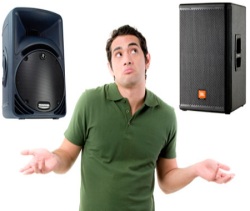One of the most common questions from church sound personne is whether they should purchase powered loudspeakers and subwoofers or passive (unpowered) loudspeakers driven by amplifiers.
This is, of course, entirely dependent on the situation.
Just a few of the questions include:
“Will the system be portable or installed?”
“Will the connections on the installed loudspeakers be easily accessible?”
“Will the people using the portable system be able to lift the loudspeakers?”
“Where is electricity more readily available?”
“Is there an air-conditioned location close to the where the amplifiers will be?”
And so many more…
The long and short (or the “light and heavy”) of it is that you need to think about your application. I personally love using powered loudspeakers for portable church systems, since there are fewer cables to lug around, and I’m strong enough to manhandle them on and off poles.
I’ve seen portable setups become semi-installed setups because the people using the system were not able to move the speakers. I tend to prefer the use of passive loudspeakers for installation, but there are many cases where powered models are much more practical.





















